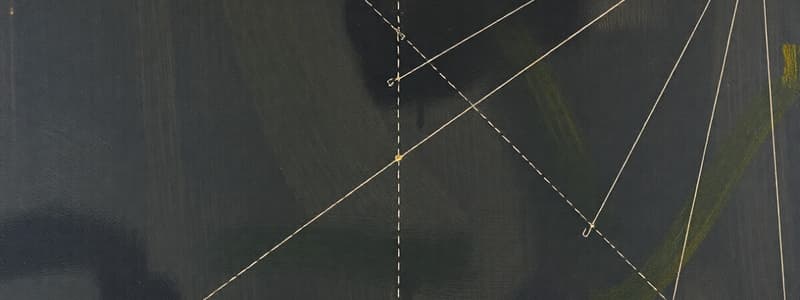Podcast
Questions and Answers
Reproduction is a principal feature of life.
Reproduction is a principal feature of life.
False (B)
Metabolism involves only breaking down substances.
Metabolism involves only breaking down substances.
False (B)
Irritability refers to an organism's ability to respond to stimuli.
Irritability refers to an organism's ability to respond to stimuli.
True (A)
The earliest atmosphere on Earth was rich in oxygen.
The earliest atmosphere on Earth was rich in oxygen.
The first life forms used RNA but not DNA as their genetic material.
The first life forms used RNA but not DNA as their genetic material.
The chemical origin of life is referred to as biogenesis.
The chemical origin of life is referred to as biogenesis.
The Earth is estimated to be approximately 4.6 billion years old.
The Earth is estimated to be approximately 4.6 billion years old.
A 'naked gene' refers to a protein molecule not enclosed in a membrane.
A 'naked gene' refers to a protein molecule not enclosed in a membrane.
Simple sugars like glucose can form from inorganic substances.
Simple sugars like glucose can form from inorganic substances.
Proteins are made up of glycerol molecules.
Proteins are made up of glycerol molecules.
The first cells were likely prokaryotic.
The first cells were likely prokaryotic.
The early atmosphere contained abundant free oxygen produced by volcanoes.
The early atmosphere contained abundant free oxygen produced by volcanoes.
ATP is the only source of energy for cells.
ATP is the only source of energy for cells.
The earliest life forms were photosynthetic.
The earliest life forms were photosynthetic.
Coacervates are simple cells with a nucleus.
Coacervates are simple cells with a nucleus.
The biological evolution is also known as biogeny.
The biological evolution is also known as biogeny.
The primitive earth's atmosphere had high levels of $O_2$.
The primitive earth's atmosphere had high levels of $O_2$.
The age of the earth is 3.7 billion years.
The age of the earth is 3.7 billion years.
The monomers of proteins are amino acids.
The monomers of proteins are amino acids.
Metabolism refers to the process where organisms move from one place to another.
Metabolism refers to the process where organisms move from one place to another.
Flashcards
Reproduction
Reproduction
The ability to produce offspring, ensuring the continuation of species by creating new individual organisms.
Metabolism
Metabolism
The sum of all chemical processes that occur in an organism, including anabolism (building up) and catabolism (breaking down).
Irritability
Irritability
The capacity of living organisms to respond to stimuli or changes in their environment.
Chemogony
Chemogony
Signup and view all the flashcards
Naked gene
Naked gene
Signup and view all the flashcards
Biogeny
Biogeny
Signup and view all the flashcards
Study Notes
- The problem sheet focuses on coordinate geometry.
Problems
- Question 1 involves finding the equation of a line through two points, a perpendicular line, and their intersection. The points A, B, and C have coordinates (-2,1), (2,2), and (4,-3) respectively.
- Question 2 asks for the equation of a line through a point perpendicular to a given line. The given line (L) has equation y = 5x - 3 and the point A has coordinates (3,4).
- Question 3 involves finding equations of lines related to a triangle. The vertices of the triangle ABC have coordinates A(2,5), B(5,-1), and C(6,2).
- Question 4 is about finding the intersection of two lines and a parallel line through a given point. The lines L1 and L2 have equations y = 3x + 5 and y = -2x + 1.
- Question 5 deals with finding the perpendicular bisector of a line segment. The points A and B have coordinates (-3,5) and (5,-1).
- Question 6 involves finding the value of k for parallel lines. The lines L1 and L2 have equations 4x + 6y = 3 and kx + 9y = 5.
- Question 7 asks for the equation of a circle with a given center and radius. The circle has a center at (-1,4) and a radius of 5.
- Question 8 requires finding the center and radius of a circle from its equation. The circle has the equation $x^2 + y^2 - 4x + 6y = 12$.
- Question 9 involves finding the intersection of a circle and a line. The circle C has the equation $(x - 5)^2 + (y + 2)^2 = 20$
- Question 10 is about finding the radius and tangent of a circle. The circle C has center (4,-1) and passes through the point P(7,3).
- Question 11 asks for the point of contact of a tangent to a circle. The line y = x + 5 is a tangent to the circle with center (3,-2).
Solutions
- 1a: x + 4y - 2 = 0
- 1b: 4x - y - 19 = 0
- 1c: (6, 5)
- 2: y = -1/5 x + 23/5
- 3a: 2x + y - 9 = 0
- 3b: x - 2y - 2 = 0
- 3c: y = -2/5 x
- 4a: (-4/5, 11/5 )
- 4b: y = 3x - 7
- 5: 4x - 3y - 5 = 0
- 6: k = 6
- 7: $(x + 1)^2 + (y - 4)^2 = 25$
- 8: center(2, -3), radius 5
- 9a: center(5, -2), radius $2\sqrt{5}$
- 9b: (3, -6) and (5, -10)
- 10a: 5
- 10b: 3x + 4y - 33 = 0
- 11: (0, 5)
Studying That Suits You
Use AI to generate personalized quizzes and flashcards to suit your learning preferences.




